Introduction The Month of March witnessed an increase in injury cases especially in Elephants with arrow injuries leading followed closely by snares
Introduction
The Month of March witnessed an increase in injury cases especially in Elephants with arrow injuries leading followed closely by snares. Many of the arrow wounds targeted bulls, a clear indication of poaching attempts due to their huge tusks. The hotspots were Ithumba, southern Tsavo East and Tsavo West near Mwakitau. Other cases included rescue of an abandoned crocodile at a closed down facility in Bachuma gate, treatment of a sick security dog and autopsy of lion carcass. Cases are expected to reduce owing to the oncoming rains that have already started.
Case #1 Treatment of an injured Elephant:
Date: 3rd March 2014
Species: Elephant
Sex: Male
Location: Dida Harea Tsavo East
History:
The Elephant bull was reported injured by tourists visiting the southern part of the Park limping.
Immobilisation:
He was tracked down and immobilised using 17 mgs of etorphine propelled in a dan inject dart system. It took 5 minutes for the drug to take effect.
Examination:
A big wound on the left rear leg was examined and on further probing an arrow head was retrieved from the wound. Dead tissues were debrided and the septic wound cleaned using water mixed with hydrogen peroxide at a ratio of 1:1. Tincture of iodine and oxytetracycline spray was applied to the wound and a final cover of green used to cover the injured site. Long acting Amoxycillin was injected parenterally.
Prognosis: Good
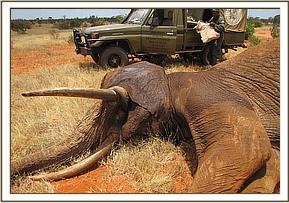
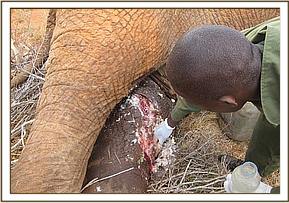
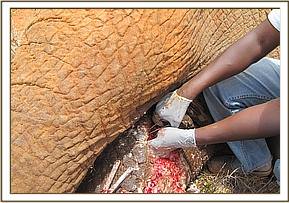
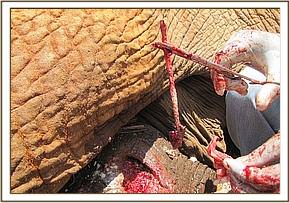


Case #2Treatment of an injured Elephant bull:
Date: 6th March 2014
Species: Elephant
Sex: Male
Location: Ithumba, Northern Tsavo East
History:
The huge tusker was treated last year for arrow wounds and appeared again at the Ithumba stockade with a huge infected wound on the left ramp.
Immobilisation:
He was immobilised using 18 mgs of etorphine near the stockade and fell down 500 metres away.
Treatment:
The wounded area was probed and two arrow heads were retrieved. Copious amounts of water mixed with hydrogen peroxide were used to clean the heavily infected wound. Pus and tissue debris was cleaned out leaving a raw clean wound. Tinture of iodine and oxytetracycline spray was applied. A final coat of green clay was used to cover the wound. Parenteral antibiotics and anti-inflammatories were injected to prevent systemic infection. He was revived and will be monitored for progress.
Prognosis: guarded.
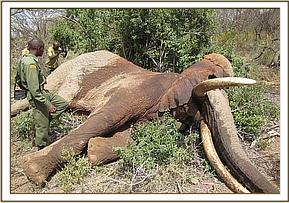


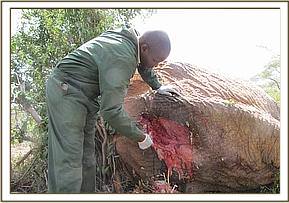
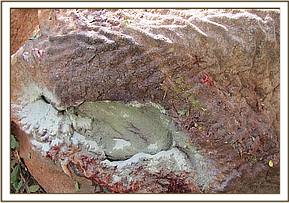
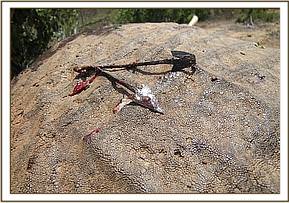

Case #3 Investigation of deaths of Doves:
Date: 7th March 2014
Species: Doves
Location: Ndii and Sagalla area Tsavo
History:
Reports of deaths of Laughing Doves were received from community members to have occurred near water holes. The team visited the area and assessed the deaths.
Analysis:
The deaths were only seen in one species of birds- laughing doves. There were no gross pathological changes observed during autopsy. The deaths were only observed near watering points- may be connected with water. After analysing the information gathered the disease was tentatively diagnosed as Newcastle disease virus (NDV) pending laboratory confirmation.
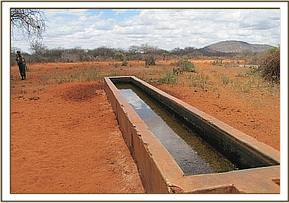

Case #4 Treatment of an injured Elephant bull:
Date: 11th March 2014
Species: Elephant
Sex: Male
Location: Tsavo East
History:
The elephant bull is among several bulls reported with arrow head wounds within Ithumba area of Tsavo east.
Immobilisation and treatment:
He was immobilized using 17 mgs of etorphine propelled in a dan inject system. He was rolled over using a vehicle and ropes after falling on the injured side. Two injuries were cleaned, disinfected and treated. The elephant was revived a given a good healing record.

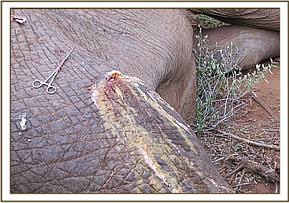

Case #5 Treatment of injured Elephant bull:
Date: 12th March 2014
Species: Elephant
Sex: Male
Location: Ithumba, Tsavo East
History:
After treating a bull the previous day another bull was spotted near the water hole with an abdominal wound.
Immobilisation and Treatment:
He was immobilized using 18 mgs of etorphine and went down within 6 minutes. He was pulled to a lateral position after leaning on a tree. The wound was cleaned, disinfected and parenteral antibiotics administered.
Prognosis: Good
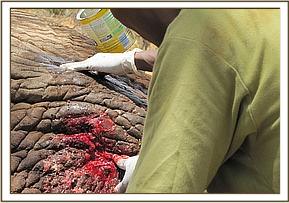
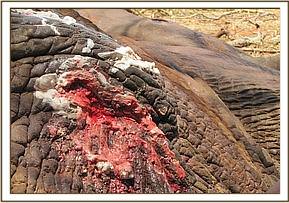

Case #6 Autopsy of a Lion carcass:
Date: 13th March 2014
Species: Lion
Sex: Male
Age: Adult
Location: Tsavo East
History:
The lion was spotted on the evening of 13th as showing no signs of movement by tourists.
Examination:
The vet team rushed only to find the massive lion already dead. An autopsy was carried out on the carcass and signs of penetrating wounds, numerous scratch wounds and bleeding were observed. The cause of death was bleeding and septicaemia caused by fight with other male lions.
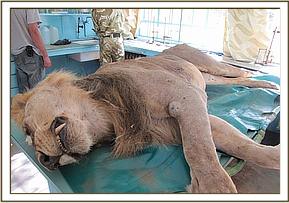

Case # 7 Rescue and wild release of crocodile at a closed down facility in Bachuma:
Date: 15th March 2014
Species: Crocodile
Location: Bachuma, Tsavo East
History:
Wildlife rescue centre is a community enterprise started in 2009 to farm crocodiles and guinea fowls for display.
Capture and Release:
By the year 2012 it started developing problems and had to be closed after an inspection which was done by the unit vet. After further consultation it was declared closed and the young croc had to be relocated. It was trapped using a capture net and moved to Galana River where it was released.
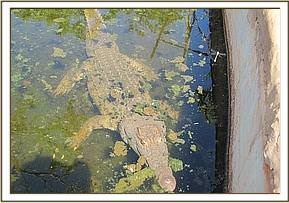



Case #8 Intensive search for a snared Rhino:
Date: 17th March 2014
Species: Rhino
Location: Chyulu Park
History:
Reports of a snared Male Rhino filtered in fast from Mukururo, Chyulu after pictures taken by camera traps showed the rhino with a tight wire snare around the neck. A massive operation that involved both air and ground team was mounted and continued for a week without success. The vet team was there to assist immobilise and desnare these endangered species. The search continues and if located the rhino will be treated promptly.

Case #9 Treatment of a security dog:
Date: 26th March 2014
Species: Canine
Location: Tsavo East
History:
The dog was brought to the clinic with history of not eating for three days, weakness and blood specks in stool.
Treatment and Prognosis:
Blood and faecal samples were taken for lab analysis and returned bacterial enteritis. Antibiotic, anti- inflammatory and vitamin supplements were administered. There was quick improvement and the dog was released back to duty after 4 days.
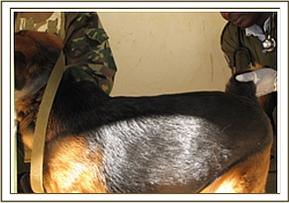
Case #10 Treatment of a snared young Elephant bull:
Date: 26th March 2014
Species: Elephant
Sex: Male
Location: Kishushe Tsavo West
History:
The case of the snared elephant was located by KWS helicopter pilot while driving elephants from community areas back to the park.
Immobilisation:
The tightly snared elephant was walking with a lot of pain. He was immobilized using 16 mgs of etorphine from a chopper and went down in 5 minutes.
Treatment:
The deeply cutting tight wire snare on the right hind leg was cut off, the septic wound cleaned with water and hydrogen peroxide. Tincture of iodine was applied and a final coat of green clay used to cover the wound. Parenteral anti-inflammatory and antibiotics was applied.
Prognosis: Good
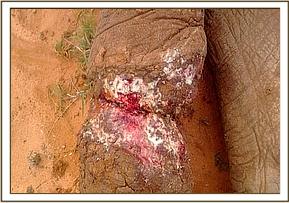
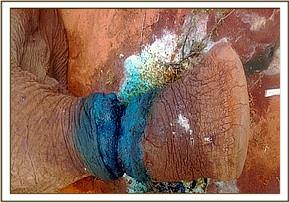

Case #11 Treatment of a lame elephant Bull:
Date: 27th March 2014
Species: Elephant
Sex: Male
Location: Olbili, Mbirikani
History:
Mbirikani is a community conservation initiative managed by Maasai preservation Trust. Its rich in wildlife biodiversity and frequented by Elephants of which most are bulls.
Treatment:
The Elephant was seen with front limp lameness and immobilized. Further checks did not show any obvious injury and the lameness was thought have been caused by a sprain. Anti- inflammatory drugs were administered and the elephant revived. The operation was carried at 8 PM due to distance.
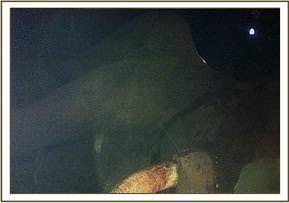
Case #12 Treatment of an injured Elephant cow:
Date: 28th March 2014
Species: Elephant
Sex: Female
Location: Tsavo West
History:
Tsavo West National park southern sector is home to large herds of elephant that sometimes stray out of the park into community areas.
Treatment:
The female Elephant was seen with a protruding arrow head on the side of the body. Darting was done using 16 mgs of etorphine in a dan-inject dart system. She went down in 7 minutes. The arrow head was removed and the wound cleaned, tissue debris removed and antimicrobials applied. A final coat of green clay was applied.
Prognosis: Good.
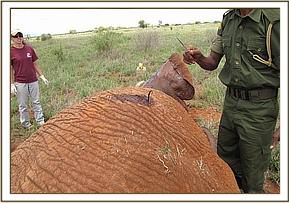
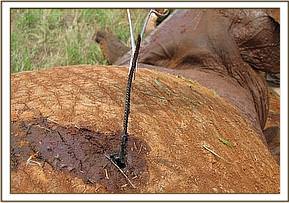

Case #13 Elephant Endotheliotrophic Herpes virus surveillance (EEHV) in Elephants in Tsavo:
Date: 29th March 2014
Species: Elephant
Location: Tsavo Ecosystem
History:
This is a latent viral disease of elephants caused by Herpes virus and is known to cause deaths only in Asian Elephants. The disease in African Elephants manifests as self limiting nodular lesions in young elephants trunk and face and are rarely fatal. The viruses are intranulclear and have affinity for endothelial cells.
Sampling:
Several Elephants were sampled and blood, tissues from nodular lesions taken and will be tested at our new molecular lab in Nairobi. A total of 15 Elephants were sampled making a total of 50 elephants sampled in Tsavo ecosystem so far.

Case #14 Treatment of an injured Elephant Bull:
Date: 31st March March
Species: Elephant
Sex: Male
Location: Dida Harea, Tsavo East
History:
The bull with heavy tusks was treated near Dida harea wind mill, southern Tsavo east for an arrow wound on the flank after reports were received by tourists.
Immobilisation:
Darting was done using 17 mgs of etophine. The Elephant had to be rolled over after falling on the injured side. The arrow head was removed, wound cleaned and antimicrobials applied. He was finally revived and given clean bill of health.
Conclusion:
The region is expected to experience continued heavy rain for the next two months that coincides with reduced case load due to water and forage abundance within the protected ares. Elephants will also have time to regain their healthy boby status.
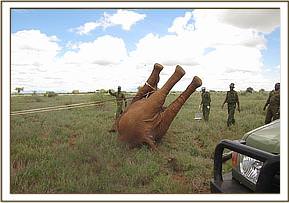
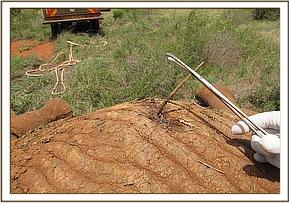
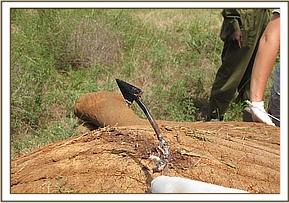

Acknowledgements:
We sincerely appreciate the good assistance extended by the unit sponsors VIER PFOTEN through the David Sheldrick Wildlife Trust (DWST) for their continued and committed funding of the operations of the unit. We also recognise the able hand of Kenya Wildlife Service (KWS) in support to the unit. Report by: Dr Jeremiah Poghon